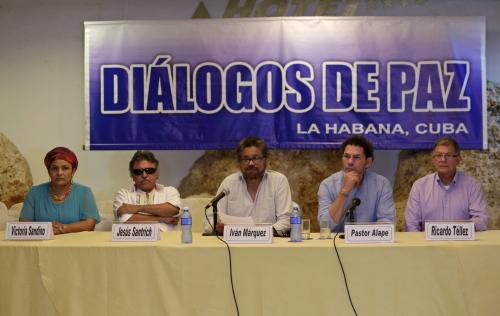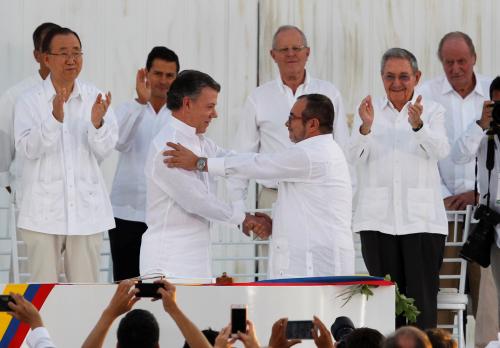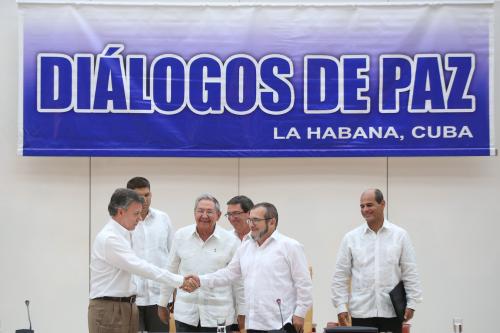Last night, the Colombian government and the Fuerzas Armadas Revolucionarias de Colombia (FARC) announced that they have agreed on an accord to end the internal armed conflict that has lasted over 50 years, taken the lives of over 200,000 Colombians, and created the highest population of internally displaced people in the world.
This is an exciting day for Colombians and they deserve to celebrate. However, this win is not one for the history books just yet. A lot still needs to happen before Colombia will actually be at peace with the FARC, and a lot can go wrong between now and then.
Here are five things you should know about the history of this conflict, the peace negotiations, and how things might evolve.
1.
The conflict has been long and costly: The internal armed conflict between the Colombian government and the FARC (an insurgent group with a socialist ideology) began in 1964; this conflict is the longest running armed insurgency in the Western hemisphere, and a large majority of Colombians has never known peace in their country. Although the conflict has generally been characterized as low-intensity due to the limited numbers of deaths it’s caused per year, it would be difficult to find a person in the country who has not been affected by the associated violence. The conflict has internally displaced 6.9 million people in a country with an estimated population of 48 million. Civilians were frequently caught in the crossfire between the government and FARC, and sexual violence was widely used as a weapon of war. Attacks on infrastructure and transportation further contributed to a general sense of insecurity.
2.Getting here was tough: The country has been disappointed twice before when previous Presidents Belisario Betancourt and Andres Pastrana conducted peace negotiations that ultimately failed. In 2000, midway through the Pastrana negotiations, the United States began to provide more substantial support to Colombia’s efforts against the FARC, beginning with Plan Colombia, an aid package jointly conceived by Presidents Pastrana and Clinton. In 2002, Colombians elected President Alvaro Uribe, who promised to take a hard line against the FARC and who significantly weakened the FARC’s forces through sustained military action by the Colombian military. When President Juan Manuel Santos took office in 2010, the population was divided between wanting peace and wanting to defeat the FARC militarily. Former President Uribe has constantly criticized the peace negotiations since they began in August 2012. Conducting talks without a bilateral ceasefire also made it difficult to maintain public support for peace when the FARC was still carrying out attacks on military and civilian targets.
3.The accord is ambitious: Although the details of the full accord have not yet been released, tentative agreements reached along the way on the five key points of negotiation (rural development, political participation, illicit drugs, addressing the conflict’s victims, and reintegration of combatants) indicate that the government has agreed to significant changes to how the Colombian state is organized. This is particularly true in the areas of restitution of land to displaced people and providing a temporary guarantee for the FARC to participate in the political process. However, Colombia has had difficulty implementing ambitious peace plans before, and previous efforts by left-wing insurgents known as M-19 to reintegrate into peaceful politics led to many of their activists being murdered by right-wing death squads. The agreement on transitional justice, which focuses on how to address the rights and needs of victims of the conflict, proved to be a highly challenging part of the negotiations. If it works, it may become a potential model for future accords to end conflicts.
4.The Colombian people must approve the accord: President Santos promised that the final decision to make peace would fall to the people via a plebiscite, which has now been scheduled for October 2. Both President Santos and the chief negotiator for the government, Huberto de la Calle, have stressed that Colombians should vote—and President Santos is adamant that negotiations will not resume in the case of a “no” vote. Public opinion around the peace negotiations has been very mixed, which suggests that President Santos has his work cut out for him if he is to convince voters to approve the agreement.
5.The accord is only the beginning: As many have already commented, after the agreement comes the hard work of building peace. This can be broken down very broadly into reestablishing government control over rural areas where state presence has historically been limited or absent, addressing the needs of victims of the conflict, and demobilizing and reintegrating former combatants in ways that contribute positively to society. On the security front, the Disarmament, Demobilization, and Reintegration process (DDR) is already a concern to Colombia watchers. It is unclear if all members of the various FARC combat and support units will agree to demobilize or if they will instead migrate into other insurgent organizations such as the Ejercito de Liberación Nacional or join Colombia’s vast network of criminal organizations. In fact, a recent experience with the demobilization of right-wing paramilitaries affiliated with the Autodefensas Unidas de Colombia under President Uribe showed that a substantial number of former combatants joined criminal organizations, known as BACRIM or Bandas Criminales. The state will have to move swiftly to establish its presence in those areas where the FARC once operated, or else these gaps will be filled by organized crime. For those insurgents that do demobilize, their success will depend on their ability to find legitimate work and the people’s ability to accept former combatants as members of their community.
Colombia’s biggest challenge now is to follow through.
Colombia’s biggest challenge now is to follow through. This process could still succumb to the same fate as previous peace accords, where a lack of state capacity at the implementation stage and the violent actions of spoilers led to continuing conflict. Fortunately, the Colombian state is more capable today than at any previous point in its history, but it does face the challenge of paying for the costs of peace at a time when its economy is underperforming and oil revenues (an important Colombian export) have fallen.
Presidents Santos and Obama have announced a new framework, Paz Colombia, by which the United States would give $450 million in assistance to support Colombia’s implementation of the peace agreements. This 25 percent increase from 2016 funding includes increased assistance for demining, alternative development, DDR, and victims. It also focuses on security, principally counternarcotics efforts. This should contribute to the success of the implementation phase, although we should also remember that Colombians themselves have invested far more than this in getting to this peace agreement. But it remains to be seen whether supporters of peace in Colombia can contain the efforts of spoilers that threaten to upend the very real achievement that this peace agreement represents.
The Brookings Institution is committed to quality, independence, and impact.
We are supported by a diverse array of funders. In line with our values and policies, each Brookings publication represents the sole views of its author(s).








Commentary
Has Colombia achieved peace? 5 things you should know
August 25, 2016